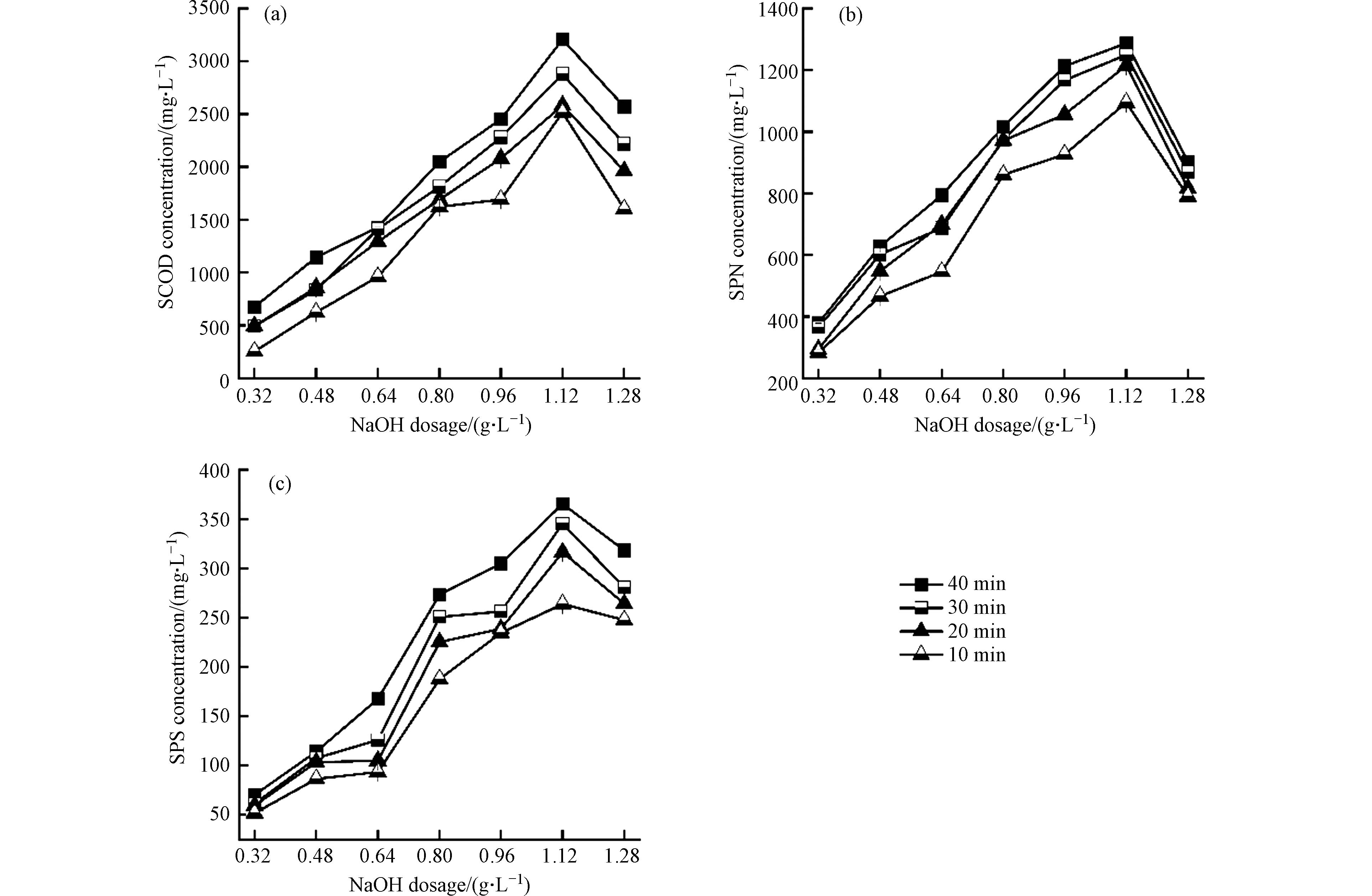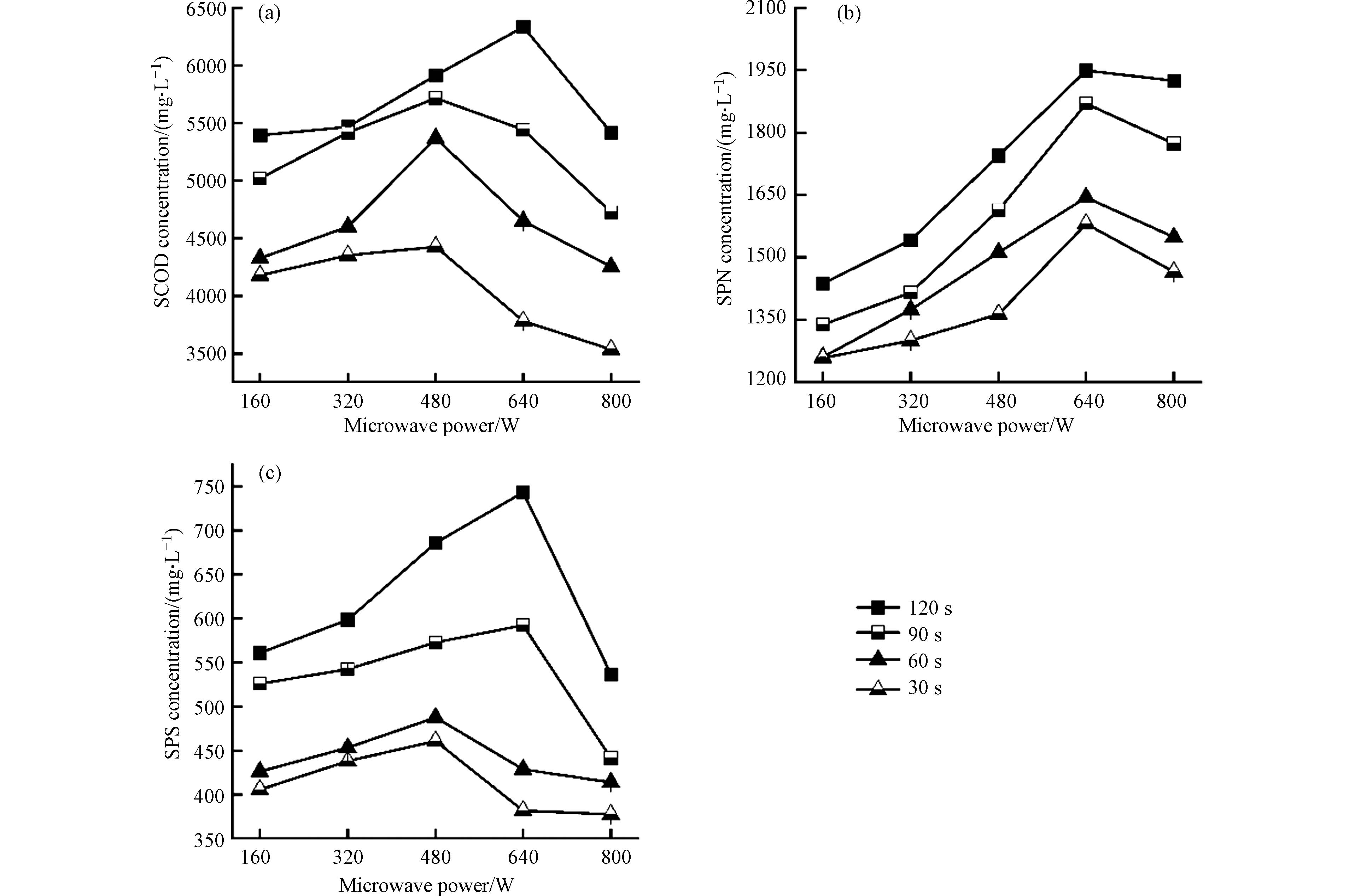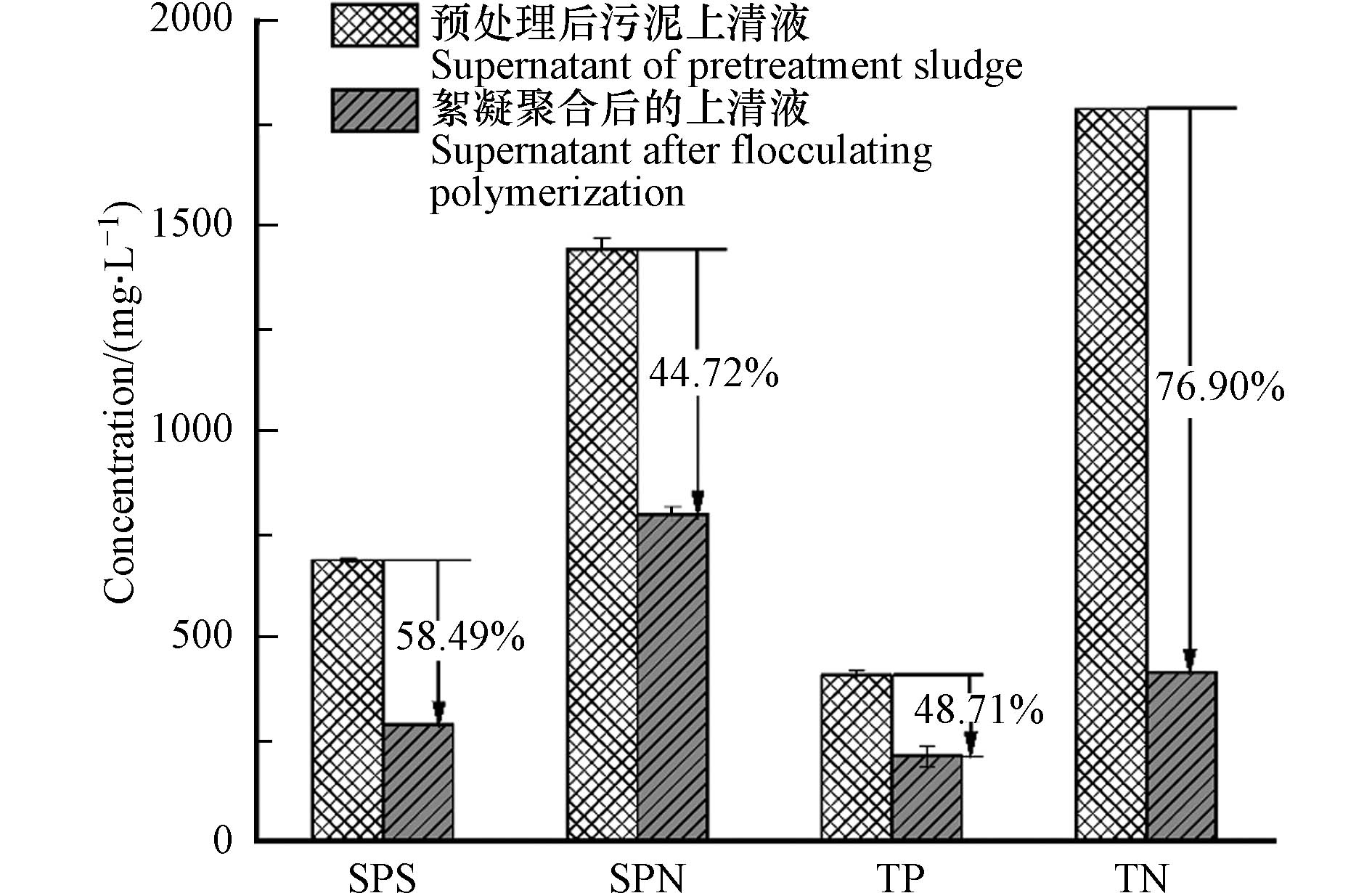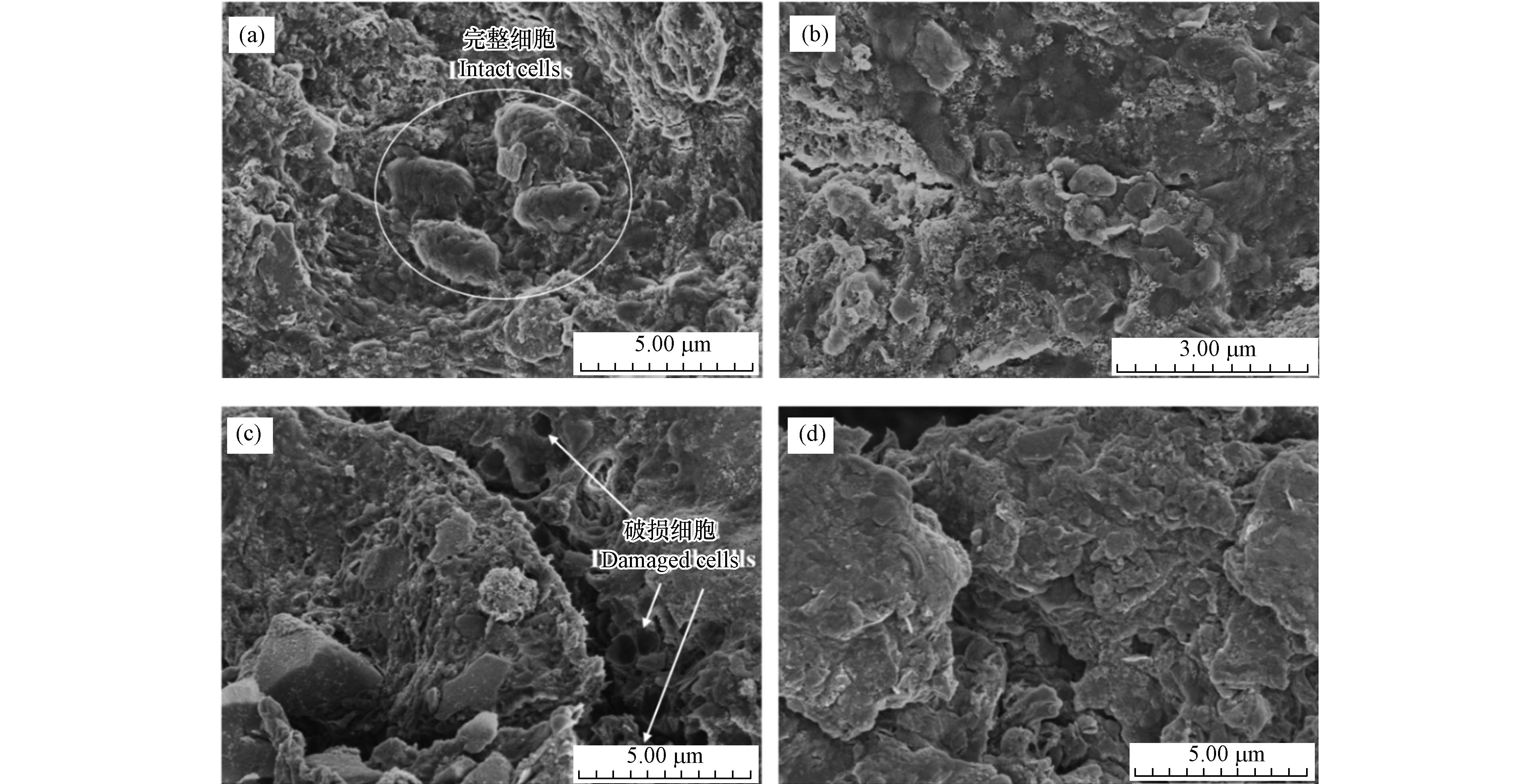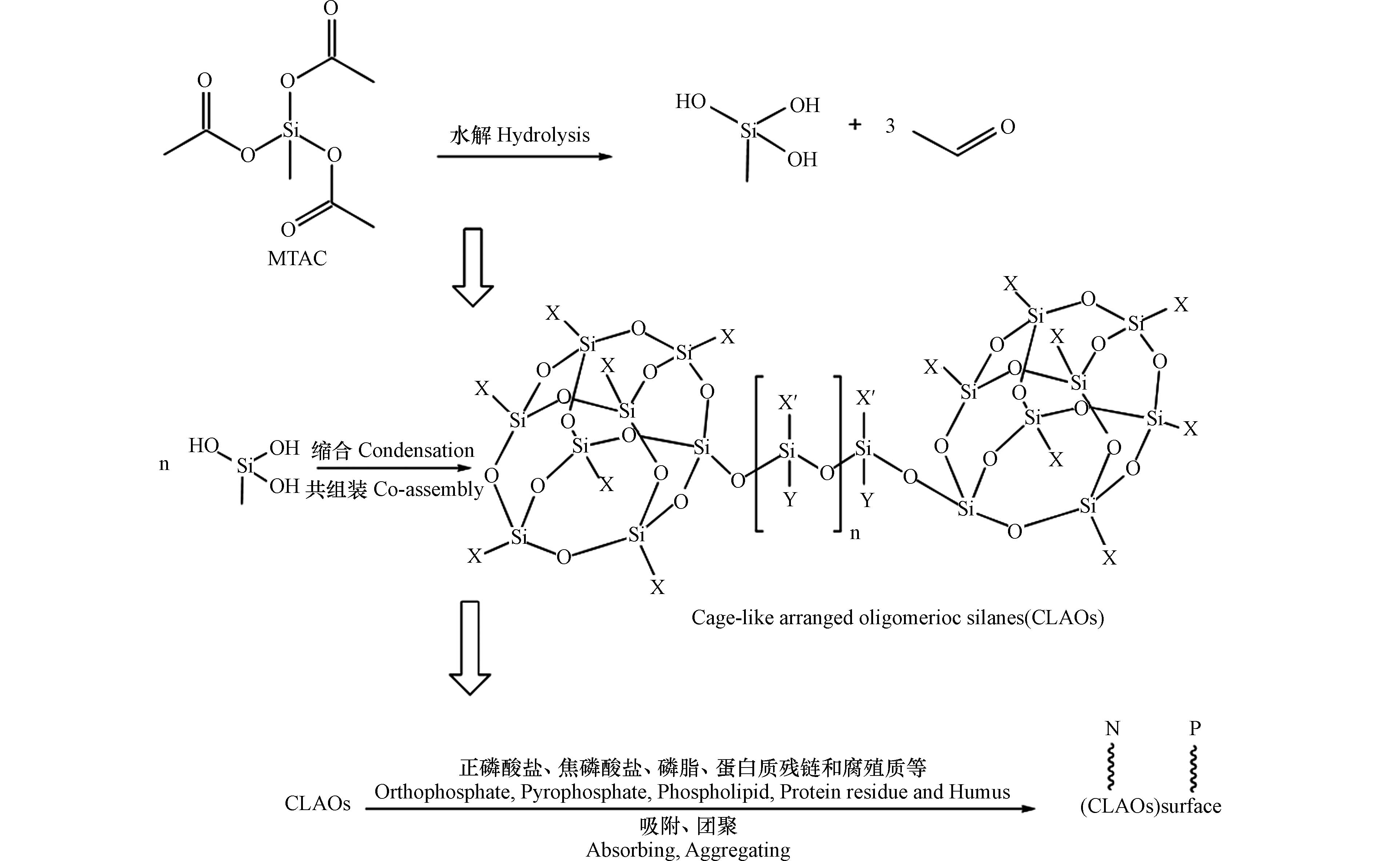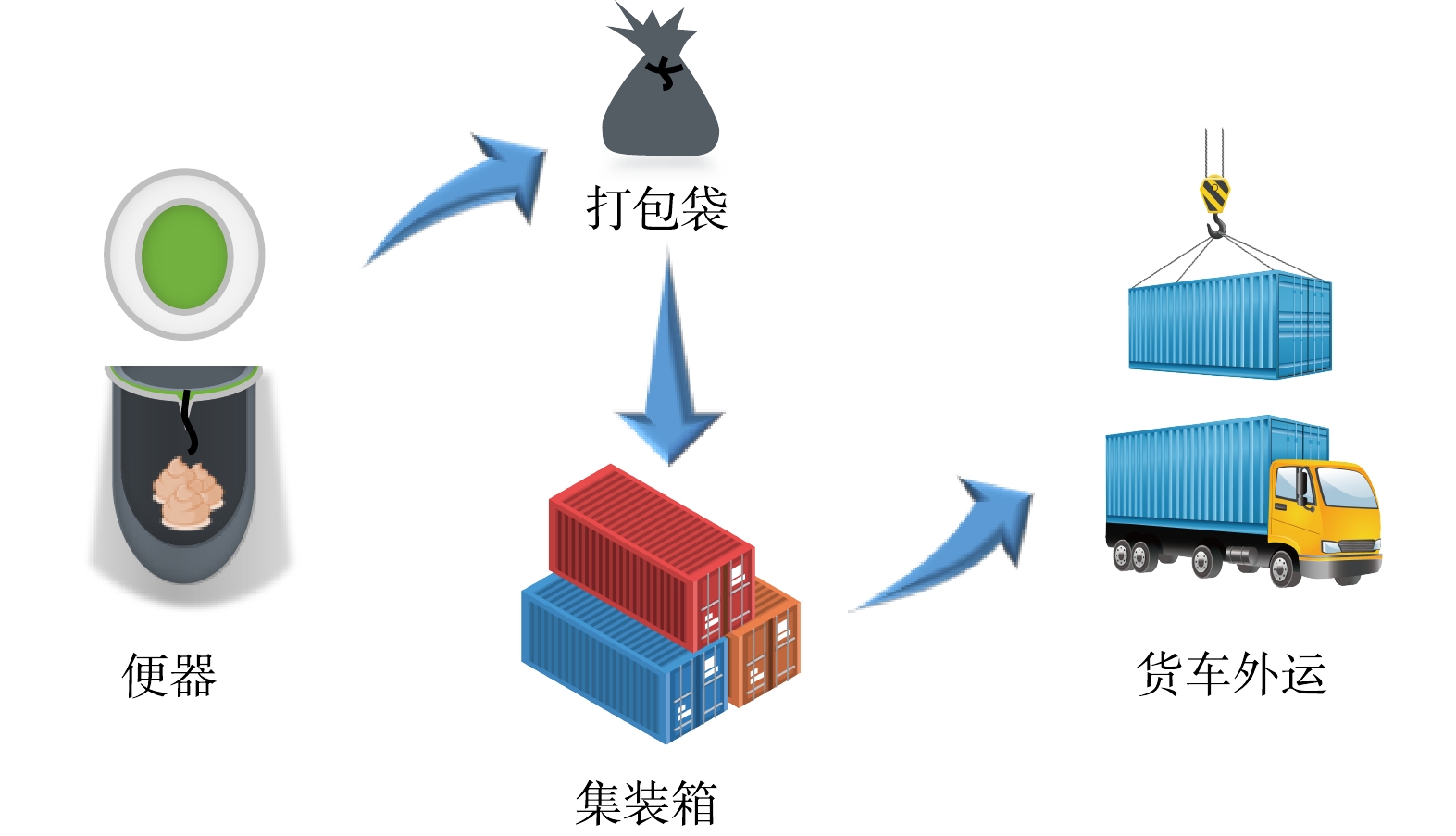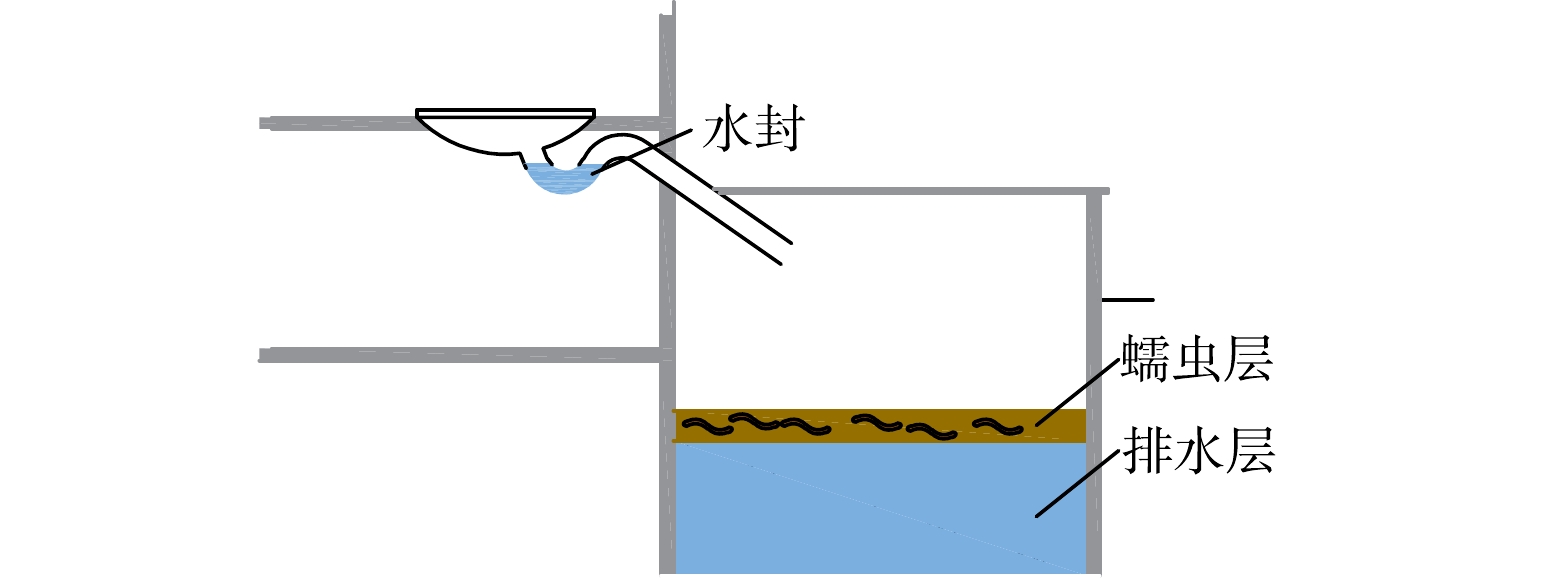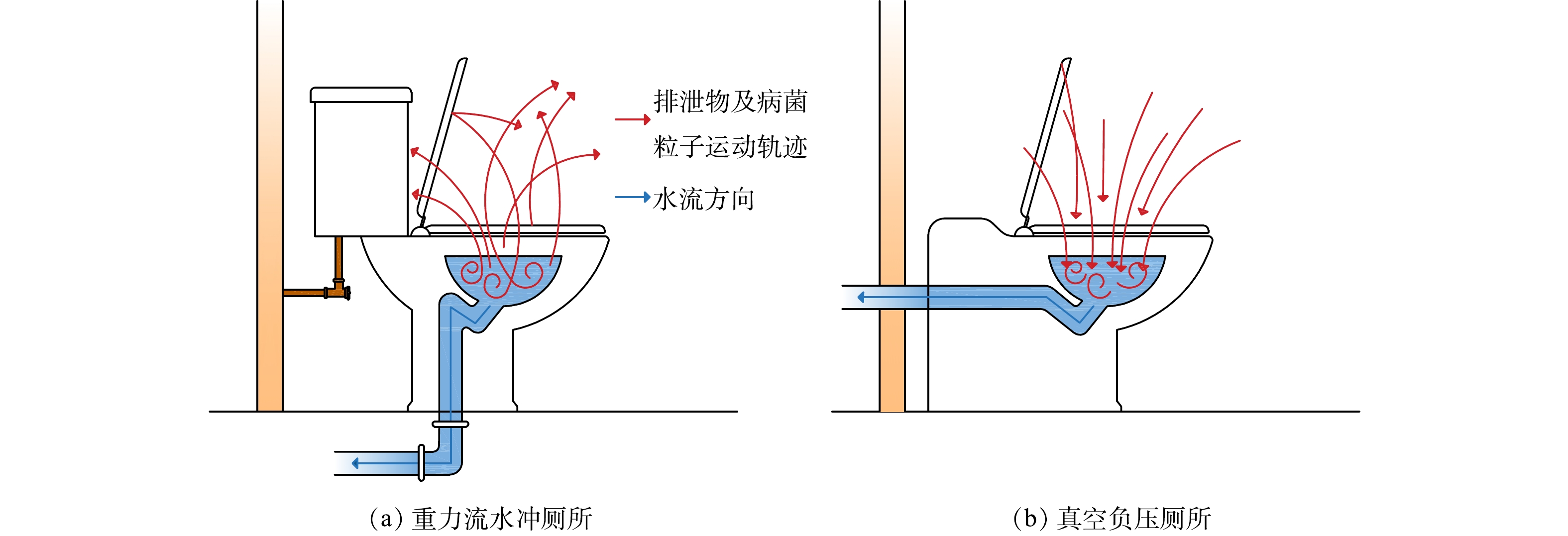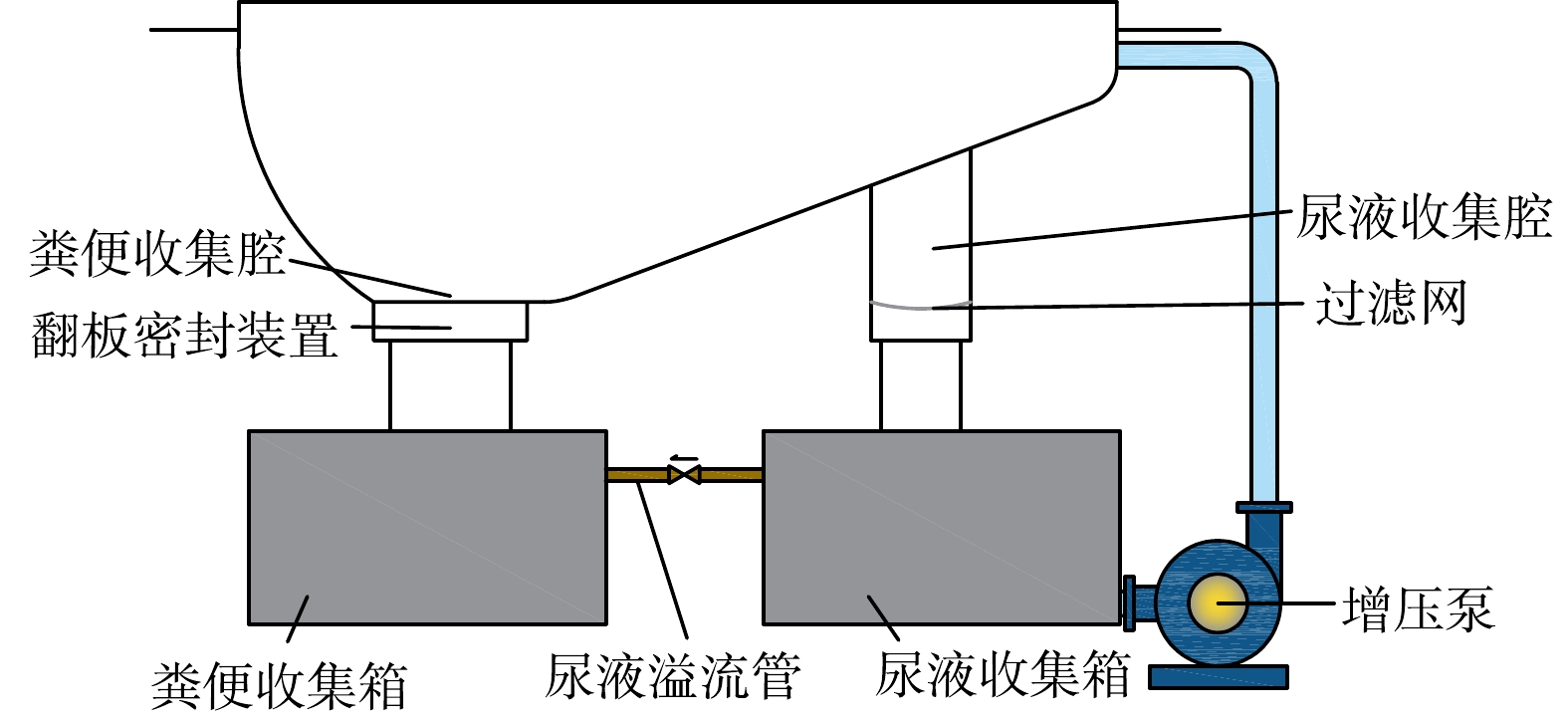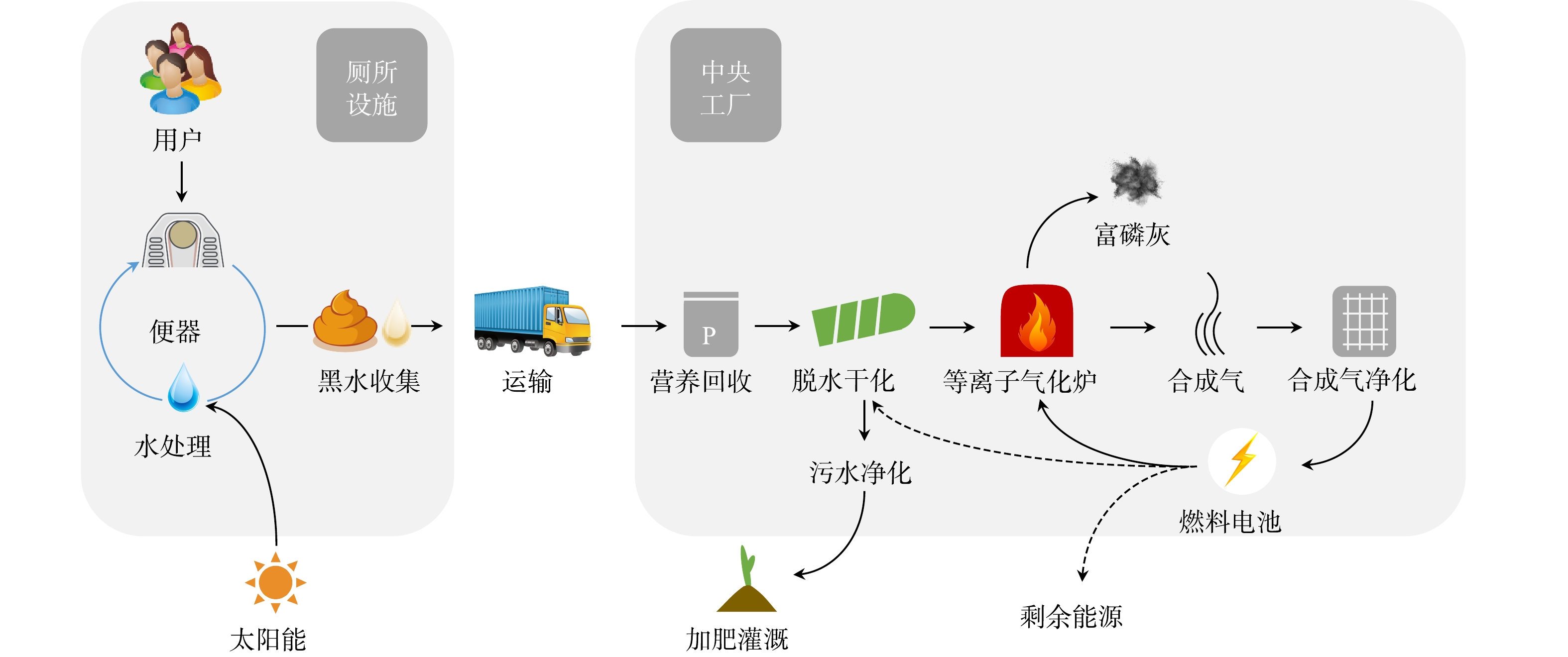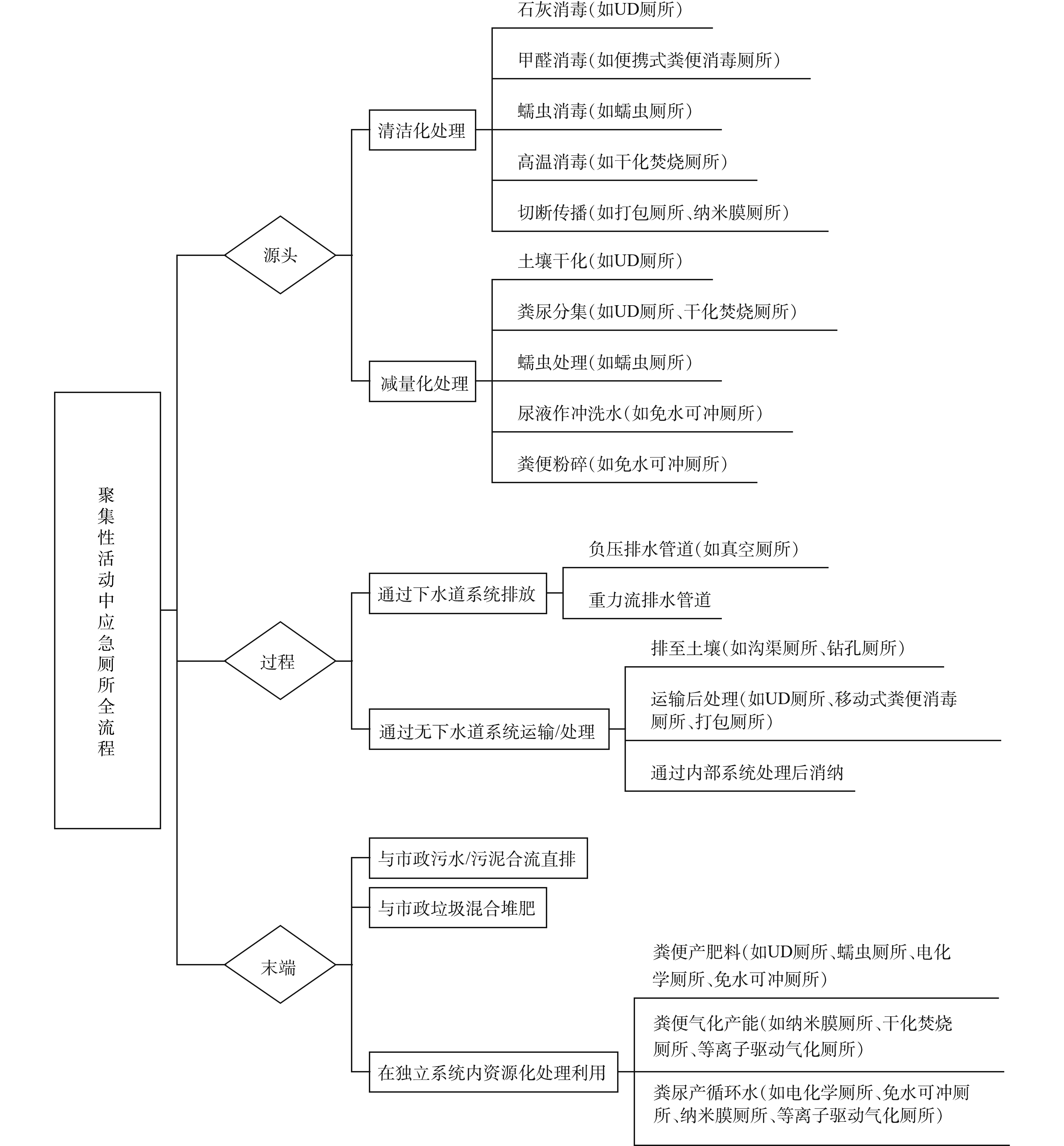-
随着城市化进程的加快,各类聚集性活动 (大型体育赛事、文艺演出等) 举办的频次提高,聚集性活动造成的影响逐渐引起关注。2013年的北京马拉松,由于缺乏足够的厕所设施,导致了运动员在沿途路边就地便溺的现象,这不仅影响了城市风貌,也存在一定细菌、病毒传播的风险[1]。目前,国内的应急厕所设施一定程度上落后于其他生活设施的发展水平,在聚集性活动中常常难以妥善解决人群的生理排泄问题,亦不能充分满足群众更高层次的需求 (私密性、安全性、舒适性等) 。
目前,国内应用于聚集性活动中的应急厕所以需要连接下水管网的传统水冲厕所为主。虽然传统水冲厕所在大部分活动情景中能够满足聚集性活动中的粪污处理需求,但在部分情景中,其水资源浪费、应用灵活度较低的问题仍尤为突出。厕所的冲水量高达3~6 L·次−1[2],这不仅造成了水资源的浪费,也加剧了对氮磷资源的回收难度。此外,部分地区基础设施的缺乏还会导致厕所难以快速与排水管网连接。无下水道卫生系统的创新发展为解决此类问题提供了解决方案[3]。
应急厕所技术在基础建设、存储运输、粪污处理等各方面都出现了多样化的发展,各类应急厕所技术只有在与相应的聚集性活动情景相适配时,才能最大化地发挥技术本身的优势。并且,不恰当的厕所粪污处理方式可能会对环境造成污染,合适的厕所粪污处理系统不仅能将排泄物对环境的影响降到最低,还可以缓解资源匮乏等问题[4]。目前的应急厕所技术领域仍存在着产品技术与适用情景难以适配、缺乏粪污处理全流程统筹规划等问题。本研究通过比较分析国内外先进的应急厕所技术,对其性能特点、适用情境进行归纳总结,并对聚集性活动中应急厕所系统粪污处理的全流程进行规划研究,以期为聚集性活动中的应急厕所技术和粪污处理模式选择提供参考。
-
根据2007年国务院颁布的《大型群众性活动安全管理条例》[5]的分类,本研究所针对的聚集性活动是指由法人或者其他组织举办,每场次预计参加人数达到1 000人以上的大型群众性活动 (如体育赛事、文艺演出等非日常举办的活动) ,根据人流量 (参与人数:x) 的不同可分为小型聚集性活动 (1 000人≤x<5 000人) 和大型聚集性活动 (x≥5 000人) 。
聚集性活动种类繁多,类型复杂,不同情景中需要的应急厕所功能和特点具有差异性。在人员集中的固定场所 (如频繁承接各类体育赛事和演唱会的体育场馆) 举办的聚集性活动,会不定期地受到巨大人流量的冲击。其中的应急厕所需要有良好的市政设施 (管网、集中式处理系统等) 作基础,或以先进的处理技术 (浓缩、循环利用等) 作支撑,以便于迅速、安全地处理大量的粪污。有些聚集性活动在举办时则没有固定的场所,比如活动范围较广、人员分散的城市马拉松,若提前设置好数量足够的固定厕所会耗费大量成本。而且,由于马拉松举办间隔较长,会在平日出现大量厕所空置的现象。因此,这类聚集性活动则要求应急厕所具有较高的灵活性、移动性,强调使用时的便利性、私密性和使用后的清洁存储、安全运输和处理。也有些聚集性活动的人流量波动较大,如常在节假日承接大量游客的展会,在建设这类活动中的应急厕所时,不仅要考虑满足高峰时期的人流量需求,也要考虑在人流低峰期减少不必要的运营支出。
根据聚集性活动定义中具有的短时、人员密集的特点,不同情景中需要的应急厕所的功能和特点也具有一致性。2019年爆发的新冠疫情凸显了对排泄物进行消毒管理的重要性。钟南山、李兰娟院士团队分别从新冠肺炎患者的粪便样本中分离出了新型冠状病毒,这一发现也证实了排出的粪便中的确存在活病毒[6],新冠病毒可以在人体胃肠系统中增值,具有粪口传播的风险[7]。相比于日常生活,聚集性活动中人员流动性大,这加快了病菌传播的速度,粪污的安全处理与处置更为重要。由于部分聚集性活动性质较为灵活,一般需要无下水道系统介入。无下水道卫生系统通过对现有的应急厕所进行技术创新改造,使其可以通过自身处理系统实现粪便管理与离网运行[8]。系统前端是用户界面 (便池、马桶等) ,后端处理技术包括生物、物理和化学等单元处理 (厌氧消化、电化学消毒、焚烧等) 。无下水道卫生系统能够满足聚集性活动举办灵活的特点,更能够通过对粪便进行安全处理、运输与处置以及隔离地下水等措施,防止病菌的粪口传播问题[9]。
-
本研究选取了一些有代表性的应急厕所技术,根据应急程度的高低分为3类,通过对各技术的性能进行比较分析,归纳出典型的处理模式,以便于和各类型的聚集性活动情景进行初步适配,具体技术特点见表1。
-
表1中列举了坑式厕所、UD厕所、移动式粪便消毒厕所和打包厕所4种典型的高应急性厕所技术。它们都具有建造方便、成本偏低、源头处理方式简易和使用舒适度偏低的特点。
1) 坑式厕所。坑式厕所是最常见的无下水道卫生系统,以简易坑厕的变化形式沟渠厕所和钻孔厕所为典型模式[11,22],沟渠厕所和钻孔厕所的结构如图1所示。作为一种简易的无下水道卫生系统,坑式厕所仅仅具有排泄物的收集、处置 (就地填埋) 功能。地下水污染是钻孔厕所容易引发的一个问题,目前仍可以在墨西哥的农村地区见到大量钻孔厕所的应用[23]。坑式厕所适用于不具有成熟的集中式排水管网系统,偶尔举办临时性小型聚集性活动的村镇地区。
2) 便携式粪尿分集厕所。便携式粪尿分集(urine-diverting,UD)厕所是在越南农村地区开发的UD干式厕所[24]和发达国家用于露营的UD无水厕所基础上开发的。UD厕所由塑料纸板制成,便于运输和储存[12]。UD厕所具有建造简便、使用清洁和成本低廉的特点,但它不具备足够的粪污储存容量,频繁运输又会消耗大量的财力。因此,该厕所技术不便于在缺乏管网连接能力的大型聚集性活动中使用。而且,通过塑料纸板制造的简易厕所,导致了它容易损坏的特点,因此UD厕所仅适用于举办频繁且使用频次不高的小型聚集性活动中。
3) 移动式粪便消毒厕所。图2是一种移动式粪便消毒厕所的示意图[11]。移动式粪便消毒厕所的技术较成熟,已有多种产品用于露营等家庭活动中[22]。基于移动式粪便消毒厕所不需挖坑、运输灵活、便于迅速投入使用和粪污能够被很好地控制隔离的特点,它也可以在一些聚集性活动中作为应急厕所使用。但是,它的运营成本较高,需要频繁进行粪污的清空和运输,不便于长期使用。
4) 打包厕所。图3是打包厕所的粪便运输流程,打包机将排泄物打包封口后,运送并储存于集装箱内,再进行外运[13]。打包密封技术能够通过集装箱运输的方式对粪便进行密封运输,对环境影响较小[25],大大减少了疾病传播的概率。而且,打包厕所的建造对于环境条件的要求不高,使用过程不需水,装置简单易检修,适用于大部分地区。
-
表1中列举了蠕虫厕所、真空厕所、免水可冲厕所和电化学厕所4种典型的中应急性厕所技术。相比于低应急性厕所,它们往往需要更多的建造成本,但具有更高的使用清洁度和舒适度。
1) 蠕虫厕所。蠕虫厕所[11,15]是指排泄物通过管道排入蠕虫层,形成蚯蚓堆肥,流出物通过排水层渗入土壤的应急厕所技术。图4是蠕虫厕所的示意图。蠕虫厕所具有资源利用率高、可持续性强、产物安全和运营成本低的特点,适于在频繁举办的小型聚集性活动中使用。
2) 真空厕所。真空排污系统作为一项成熟的技术已在全世界许多发达国家和地区大范围应用,真空厕所由负压管道两端的压力梯度驱动,通过气压差将便器内的排泄物吸入管道内。图5是普通水冲厕所和真空厕所的对比图。真空厕所对于防止病菌飞沫传播有着突出的优势[16-17]。但是,真空厕所的基建投资成本较高,真空度也会提升冲水噪声而降低使用舒适度[26]。
3) 电化学厕所。近年来,电化学(electrochemical, EC)消毒被认为是一种分散式废水处理的可行方法。有研究发现,EC消毒能够对各种水基质中的80种微生物病原体进行广谱消毒[27-28],并且EC系统有由太阳能供电的潜力[29]。EC技术可以和移动式厕所结合,形成一套资源回用率高的前端便器-后端厌氧发酵-EC处理系统[30],可以实现较高的资源利用率和较好的消毒效果。
4) 免水可冲厕所。免水可冲厕所不需水,能够利用收集的尿液冲洗粪便。图6为免水可冲厕所示意图[18],已在第29届奥运会中应用的免水可冲厕所具有节水、后期清运成本低、能耗低、负荷能力强、易搭建等优点,适合应用于资源化要求较高但举办频次较低的大型活动中[31]。
-
表1中列举了纳米膜厕所、干化焚烧厕所和等离子驱动气化厕所3种典型的低应急性厕所技术。目前,大部分低应急性厕所技术仍在研发中。比起厕具本身,低应急性厕所往往具有更加完整、独立的能源循环系统,能够更好地利用聚集性活动中短时产生大量粪污的特点产能,这也代表着未来应急厕所的重要发展方向。
1) 纳米膜厕所。PARKER等[19]开发的一种纳米膜厕所,能够利用纳米膜从上清液中回收水,从固体废物中回收能量,在不依赖大量外部能源或水资源的情况下实现粪污的原位处理。厕所使用电池供能,厕所系统的最终产物可以用来发电。纳米膜厕所对技术水平的要求较高,能够实现完整的能源循环链和较高的资源回收效率[32]。
2) 干化焚烧厕所。STOKES等[20]开发的一种能量循环利用的干化焚烧厕所,通过以下步骤运行:1) 固液分离;2) 固体废物干燥固定;3) 固体废物燃烧和液体废物消毒。该系统不需要外部能源,可以将粪污转化为燃料,部分余热被散热器收集,通过热电设备的转换,为系统提供电能[3]。同时,高温处理能够杀灭粪污中的病原微生物,切断疾病传染的途径[33]。能量的完全循环利用是干化焚烧厕所系统的一大优势,然而系统的运行需要充足的物料供给。
3) 等离子驱动气化厕所。图7是一种依托等离子体驱动气化技术的厕所粪污处理系统流程图,能够实现完全的能量循环[21]。这一技术实现了完全的系统独立,不需要外接电力设施和污水管道。等离子驱动气化系统的独立性使得自身不需要向外界输送、倾倒或处理任何废物,对资源的回收利用大大降低了运营成本,但该系统的基建费用较高。
-
聚集性活动中应急厕所全流程分析如图8所示。在厕所粪污处理的源头、过程和末端中,各自具有不同的处理侧重点。在源头,一般需要对粪污进行消毒灭菌和减量化处理以减轻后续处理系统的负担。随后,根据是否连接下水管网对处理过程进行区分。最后,对粪污进行资源化利用或直排处理。
聚集性活动中厕所系统选择的几个重要影响因素主要有活动规模、活动频次、活动范围和是否连接下水管网4点。一方面,可以根据末端的处理方法将粪污处理方法分为直排和资源化处理2类。大规模聚集性活动常常伴随着大量的粪污产生,而对大量的粪污进行集中处理可以基本抵消资源化设施的成本投入,甚至带来利润。因此,规模较大的聚集性活动产生的粪污更适合进行资源化处理。另一方面,又可以根据粪污运输距离将粪污处理方法分为原位和异位2类。异位处理的方式相对更加灵活。然而,较高的粪污运输成本限制了异位处理的长期应用,使其更适用于举办频次较低的聚集性活动。此外,活动范围和是否连接下水管网的因素也能够通过影响粪污处理的成本,从而影响处理模式的选择。适用于聚集性活动中的厕所系统模式可以归纳为5种,分别是:1) 下水道混合处理模式;2) 稳定化-原位直排模式;3) 稳定化-异位直排模式;4) 浓缩-原位资源化模式;5) 浓缩-异位资源化模式。
-
下水道混合处理模式即为粪污经由下水道运输至市政污水处理厂进行污水混合处理的模式。作为5种厕所系统模式中唯一的下水道系统,在具备市政管网连接的条件下适用于大多数聚集性活动中。虽然下水道混合处理模式较为便捷、安全,但局限性较大,应用需要具有完整的前期基建基础。由于下水道系统灵活度较低、资源利用率较差,常规的下水道混合处理模式往往难以充分满足日益灵活、大型的聚集性活动需求,比较适用于对环境清洁性要求偏高,地点固定且举办频繁的大型聚集性活动中。
-
稳定化-原位直排模式指的是,粪污产生后不进行转移或输送,而在原地进行稳定化处理后直接排放的模式。稳定化-原位直排属于无下水道厕所系统中最为简易的一种模式,仅仅保留了对粪污的基础清洁和安全处置过程。如沟渠厕所和钻孔厕所系统就是典型的原位稳定化-直排模式,往往通过在粪污上方人工放置覆土的方式以起到隔绝气味、减少污染的作用,实现初步的稳定化[11]。它们可以在短时间内快速构建,但其坑式构造易使地下水被污染,需要较为频繁的监督维护[10]。此外,由于该模式下的粪污不向外输送,直接在源头处理和处置,而厕所的容量有限,最终能承接的粪污量很低。因此,坑式厕所适用于不具有成熟的集中式排水管网系统,对厕所设施的应急需求较高的小型聚集性活动中。
-
稳定化-异位直排模式指的是,粪污产生后转移或输送至外部处理设施进行稳定化处理后直接排放的模式。稳定化-异位直排模式下的厕所系统灵活性较高,如移动式粪便消毒厕所和打包厕所的便器都具有较高的便携性,但也因为它移动便携的特点,导致便器无法承装大量的粪污,需要频繁进行运输清空。与稳定化-原位直排模式使用覆土简单稳定粪污的方式相比,该模式中为了确保运输安全,一般使用特制的容器和药剂来稳定粪污,如移动式便携消毒厕所内部的储存罐含有能够减少臭味外溢、初步消毒的化学清洁材料[11],部分打包厕所的打包袋含有分解有机物的酶,或具有吸水功能,能够初步实现粪污的减量化[14]。考虑到粪污运输成本的限制,稳定化-异位直排模式下的厕所系统常适用于举办频率较低,人流量偏小且对清洁性要求较高的小型聚集性活动中。稳定化-直排模式中的粪污也有资源化利用的潜力,但由于该模式下粪污产量往往较小,且一般仅在源头经过简单的稳定处理,考虑成本的限制一般不适于进行资源化利用。
-
浓缩-原位资源化模式指的是,粪污产生后不向外部转移或输送,而是在源头进行减量化处理以减小粪污体积,之后在系统内部通过完整的循环系统实现粪污资源化利用。该模式下的粪污通过源头的浓缩处理和末端的资源化利用,能够明显减小粪污的体积,以便于系统不会较快地被粪污占据而无法继续使用。蠕虫厕所是比较典型的浓缩-原位资源化系统之一,已在乌干达有广泛应用,以缓解当地坑厕填充过快的问题[34]。1 kg人类粪便约可以转化成100~200 g蚯蚓堆肥,蚯蚓堆肥约每5年排空1次[15]。在规模较大的蠕虫厕所设施中,蚯蚓培育费用并不会占据过大的成本[35]。规模的提升可以在一定程度上减少资源化利用的成本,这也是浓缩-原位资源化模式主要适用于大型聚集性活动的主要原因。如研发中的电化学厕所、纳米膜厕所和干化焚烧厕所等系统,均能够在更大覆盖范围的前提下提升厕所技术的资源利用效率、人员分配效率和使用舒适度,这些优势也能够与越来越频繁、大型的聚集性活动举办趋势相适应。
-
浓缩-异位资源化模式指的是,粪污产生后在源头进行减量化处理以减小粪污体积,随后向外部转移或输送,实现粪污的资源化利用。该模式中的厕所技术相比于稳定化-原位直排模式而言,一方面在源头增加了源分离和无害化预处理步骤,以便于提高粪污资源化的转化效率,另一方面设置了更为灵活的厕所设施,以便于转移粪污,减轻分散化处理的成本负担。如UD厕所中的粪便在与尿液分离后,通过石灰和干燥介质 (如碳化稻壳或干燥土壤) 的混合处理,以实现干燥、碱化、消毒、除臭,最终可安全地用于农业堆肥或填埋[12]。免水可冲厕所同样在源头进行了粪尿源分离,厕所的结构大大提高了尿液的纯度,能够实现粪污的减量化、无害化和可资源化。粪污的收集运输成本和便器非固定导致的损耗是限制该模式下厕所技术发展的重要原因。
在无下水道系统中,稳定化-直排模式中厕所技术倾向于从原位向异位转变,而浓缩-资源化模式中厕所技术则倾向于从异位向原位转变。稳定化-直排模式的优势在于厕所技术简单和设施建造简便,原位直排不够卫生和粪污储量小的缺陷较为明显,而异位直排可以及时清空粪污,在处理源头和末端进行更加灵活的稳定化处理。浓缩-资源化模式的优势则在于资源利用率较高,又由于该模式往往适用于较大型的聚集性活动,粪污产量较大,为降低运输成本,内部循环的原位资源化系统是更合适的选择。
-
在复杂人员参与的聚集性活动中,人体排泄物未经处理而直排入土壤或下水道会造成较高的病菌传播概率。在粪污处理的全过程中,包括如厕和排泄物的存储、运输、处理与处置,都存在着人体暴露于粪污病原体的风险。消毒灭菌作为粪污源头处理的重要步骤之一,随着新冠疫情常态化的趋势,逐渐受到了更多的关注。
对于粪便中指示性微生物的灭菌一直是粪污卫生安全处理的重点。研究表明,紫外线照射、75%乙醇或有效氯消毒剂的喷洒或擦拭能够有效灭活厕所内部表面的病原体[9]。在部分聚集性活动中,有时会由于主办方管理不够成熟或活动条件限制,需要使用者对粪污进行简单的消毒灭菌操作。尹福斌等[36]发现,加碱 (如氨或石灰) 作消毒剂对粪尿进行初步消毒可以有效去除粪便污泥中的指示性微生物 (粪大肠杆菌、粪链球菌、沙门氏菌) 。此外,作为新的研究热点的新冠病毒,在重力流污水管道系统抽送的过程中,会雾化并作为气溶胶进行传播[37],在塑料和不锈钢便器表面可存在2~3 d[38]。针对新冠病毒的灭活研究表明,氯基消毒剂具有杀菌谱宽、灭活效率高、易分解、残渣少等优点,是目前较为经济的新冠病毒消毒剂[39]。
在聚集性活动中,当设施足够发达、管理资源充足的情况下,应以氯基消毒剂作为主要消毒手段在源头阻隔病毒的传播,并在后续的运输、处理与处置过程中采用合适的阻隔或消毒手段防止病原体外溢。在部分缺乏充足消毒条件的聚集性活动中,也应确保采用合适的消毒手段 (如加碱) 对粪污进行初步的病原体阻隔或杀灭操作。聚集性活动中的人员组成复杂,极易形成交叉感染,应尽量避免应用无法进行消毒或病原体阻隔的厕所粪污处理技术 (如土壤直排、重力流下水道直排等) 。
-
随着科技的发展进步,人们的生活变得更加便利。当聚集性活动中的参加者活动范围更广、活动区域更灵活时,厕所的固定属性就显得不便。虽然完整下水道水冲式厕所是现阶段实现厕所粪污处理最流行、最卫生的解决方案,但是已无法充分满足高频、大型、灵活的聚集性活动需求。无下水道卫生系统则在厕所的移动性发展上展现了较高的潜力。
无下水道卫生系统是分散污水处理的一种方式,通过在源头对粪污进行收集和处理,避免了长距离运输成本的投入和对中央下水道系统的破坏。无下水道系统对于水资源有限、卫生基础设施不足的发展中地区而言更具有实用价值[40]。根据厕所便器对水的需求程度,可将无下水道厕所卫生系统分为循环冲洗模式、微水冲模式和免水旱厕模式。在聚集性活动中,人们对于应急厕所的需求从最初能基本满足生理需求的免水旱厕模式,已逐步发展为目前主流的便携式微水冲模式。从“人找厕”到“厕跟人”,如厕的便利性可以在更广泛的时空范围中实现。无下水道厕所系统正向着移动性更高、覆盖范围更广的小型微缩循环系统发展。然而,在应用于聚集性活动的无下水道系统的技术成熟度和管理方面,目前仍然缺乏统一的评价标准[41]。
-
随着无下水道系统的不断发展,对于粪污末端处理方式更多地倾向于以资源化的形式回收能源。大多数情况下,粪便中未稀释的液体组分盐度过高,难以直接在农业中应用,粪污中的固体组分经稳定化处理而达到要求的卫生质量后,可以作为有价值的土壤改良剂和肥料进行资源化利用[42]。图9是粪便污泥处理的典型工艺路线。
在聚集性活动的应急厕所技术发展变化中,由于无下水道系统能满足聚集性活动举办地点灵活分散的特点而逐渐占据了主流。无下水道系统分散处理粪污的特性也便于对粪污进行资源化处理。目前对于粪污处理趋于在源分离-安全处理与处置的前提下向着固体气化-产能量、固体堆肥-产肥料、液体净化-水资源循环利用的方向发展。
-
智慧厕所的目标是通过适当的智慧化措施提供充足、完善的卫生服务,以确保所有的使用者都能够获得足够的卫生资源[43]。在现有技术下,智慧厕所这一目标仍未完全实现。聚集性活动中的厕所往往人流量较大,很难通过人力进行完善的卫生监管,并且常常出现拥堵的现象。因此,利用日益发达的物联网技术,完善满足聚集性活动需求的智慧厕所系统十分必要。
在厕所内设置气味传感器、湿度传感器、超声波传感器、红外传感器、声波传感器等设备[43-45],可以对厕所进行气体安全、污水排放、水位高低等问题的监测,并在厕所异常运行时及时通知维修部门检修,大大节约了人力资源的投入。同时,在物联网技术的帮助下,传感器能在不同的公厕内收集相关参数 (如如厕的人流量、性别差异、大便/小便行为差异、每人次使用时长、每人次用水量等[46]) 并将其上传数据库,再将数据传输到使用者的电子设备上[44]。通过物联网的介入,使用者能够方便地在聚集性活动中确定厕所的空余位置与清洁情况,为使用者节约了寻找和清洁厕所的时间。在未来,聚集性活动中的厕所将通过完善用户检测、污垢检测、气味感知、清洁者监控、节水等模块[45]为使用者提供更加卫生、清洁、智能的全面服务。
聚集性活动中应急厕所技术及适用情景分析
Analysis of emergency toilet technology and its application in gathering activities
-
摘要: 我国聚集性活动的频度和规模越来越大,活动中应急厕所的大量使用已成常态。然而,不免存在厕所基础设施不完善、粪污处理措施不合适而导致的不安全、不卫生、不环保等问题。因此,聚集性活动中应急厕所技术受到了越来越多的关注。应急厕所设施和粪污处理方式的选择,一方面与环境条件的限制有关,另一方面与使用者的需求发展有关。归纳了聚集性活动中厕所系统粪污处理流程,提出了聚集性活动中应急厕所粪污处理典型模式,以及现有模式的缺陷和未来的发展方向,以期为聚集性活动中的厕所技术和系统模式选择及技术研发方向提供参考。Abstract: At present, domestic gathering activities are held more and more frequently, but there is still a lack of scientific guidance on the necessary emergency toilet technology. The toilet infrastructures are incomplete, and the fecal treatment measures are not appropriate, resulting in imperfect, unsafe, unclean and other problems frequently. Therefore, more and more attention has been paid to the emergency toilet technology in gathering activities. The selection of emergency toilet facilities and fecal sewage treatment methods is related to the restriction of environmental conditions on the one hand, and the development of human needs on the other hand. For this reason, the treatment process of toilet system feces in the gathering activities was summarized in this paper. The typical model of emergency toilet sewage treatment in gathering activities, as well as the defects of the existing model and the future development direction were put forward for the first time in this paper. This work has important implications for toilet technology, system mode selection and technology development direction in gathering activities.
-
Key words:
- gathering activities /
- emergency toilet /
- fecal sludge /
- excreta disinfection /
- excreta recycling
-
近年来我国经济的飞速发展,城市生活污水污泥产量连年攀升,随之而来的是污泥处理的压力。一方面,剩余污泥含有重金属、有机污染物和病原微生物等有毒有害物质,如果处理不当,会给环境造成严重污染。另一方面,污泥是一种拥有巨大潜力的生物资源,其有机质含量在50%左右,含有丰富的蛋白质、多糖、腐殖酸和核酸[1]。在传统污水二级生化处理中,进水中近90%的磷和部分的氮最终会转移至污泥中,因此剩余污泥含有丰富的有机质和氮磷养分,若不加以合理利用是一种资源浪费。
污泥固相中营养物质的有效释放是实现污泥有机质和氮磷回收的重要前提。污泥的破解方法有各种物理化学法,如热水解、超声、高压均质法等。碱处理作为一种常用的化学预处理方法,具有操作方便、设备简单、效率高等优点。首选NaOH作为处理试剂,其比Ca(OH)2有更高的增溶效率[2]。碱法常常与其他工艺(如超声[3]、热处理[4]和高压均质法[5]等)联合处理,联合处理对污泥具有更高效的破解能力。微波法在污泥处理中的潜力已得到广泛认可[6],微波产生的热效应和非热效应能高效破解污泥,所以碱联合微波组合工艺拥有巨大潜力。
为了回收利用污泥上清液中丰富的营养物质,可通过磷酸铵镁沉淀法回收氮和磷,其产物鸟粪石可作缓释肥料。但实际应用中受各种因素(例如高离子强度、高碱度和Ca2+干扰)限制[7],且磷酸铵镁沉淀法只能回收PO43--P和NH4+-N等形式的无机盐,上清液中丰富的有机质仍无法利用。硅烷交联剂是一种两性表面活性剂,一个分子中同时拥有烷氧基和有机官能团,烷氧基水解产生的硅烷醇基团能以共价键的形式与无机材料结合,有机官能团与聚合物作用,可显著提高无机/聚合物表面附着力[8]。因此,硅烷交联剂有望解决污泥上清液中有机质无法高值利用的问题。硅烷交联剂成本低、环境友好,被广泛应用于复合材料、纳米材料等表面改性。近年来学者们将其应用于环境领域,Zhou等使用(3-氨基丙基)三乙氧基硅烷有效分离水溶性腐殖酸[9]。甲基三乙酰氧基硅烷(MTAC),常温下为无色透明液体,低温下为白色结晶体,结构式为CH3—Si—(COOCH3)3,其酰氧基相较于其他基团(如甲氧基、乙氧基)更为活泼,分解速度也更快[10]。并且根据美国环境保护署的数据资料显示,MTAC的半数致死浓度(LD50)为2060 mg·kg−1,属于低毒化合物。MTAC与水就能交联,生成具有良好生物相容性的聚硅氧烷和易生物降解的乙酸,且污泥上清液中氮元素的嵌入能够加速聚硅氧烷的水解,从而提高其生物降解性[11]。因此,MTAC的交联聚合反应是一种从污泥上清液中回收有机质和氮磷的有效途径。
本研究采用碱联合微波组合工艺预处理污泥,投加MTAC回收上清液中有机质和氮磷,研究了碱联合微波处理对污泥中有机质及氮磷的释出的影响并优化反应条件,探究了MTAC交联聚合回收污泥上清液营养物质的可行性,利用扫描电镜-能谱(SEM-EDS)、傅里叶红外光谱图(FTIR)、X射线光电子能谱分析(XPS)和热重差示扫描量热法(TG-DSC)对絮凝聚合物进行形态和化学构造分析,旨在探究交联聚合法分离回收有机质和氮磷的机制。
1. 材料与方法(Materials and methods)
1.1 污泥来源及特性
试验所用污泥取自上海某城镇污水处理厂污泥浓缩池,该厂采用A2O活性污泥处理工艺,污泥取回后过筛去除直径大于4 mm的杂质,保存在4 ℃冰箱备用。具体理化性质如表1。
表 1 污泥的基本理化特性Table 1. Physicochemical characteristics of the sludge含水率/%Moisture content pH 总固体/(g·L−1)TS 挥发性固体/(g·L−1)VS 溶解性化学需氧量/(mg·L−1)SCOD 溶解性蛋白质/(mg·L−1)SPN 溶解性多糖/(mg·L−1)SPS 总磷/(mg·L−1)TP 总氮/(mg·L−1)TN 97.76 ± 0.3 6.80 ± 0.2 22.4 ± 0.6 10.4 ± 0.4 181.75 ± 13.1 84.16 ± 5.3 26.34 ± 2.8 70.44 ± 6.1 2.70 ± 0.1 1.2 实验方法
本试验分别投加梯度剂量(0.32、0.48、0.64、0.80、0.96、1.12、1.28 g·L−1)的NaOH于250 mL污泥中,用磁力搅拌器(150 r·min−1)保证反应充分进行,间隔固定时(10、20、30、40 min),取样分析以确定NaOH的最佳剂量。污泥经碱处理最佳条件后,用不同功率(160、320、480、640、800 W)微波照射,间隔固定时间(30、60、90、120 s),取样分析以确定碱联合微波处理最佳条件。污泥经碱联合微波最佳条件处理后,在3000 r·min−1下离心10 min得到污泥上清液,投加梯度剂量(0.038、0.076、0.134、0.189 mol·L−1)的硅烷交联剂-甲基三乙酰氧基硅烷(MTAC)待反应完全,离心得到聚合后的上清液,真空干燥得到的絮凝沉淀物用于后续分析。
1.3 分析方法
污泥的TS、VS 和上清液中的SCOD、TN和TP根据美国APHA标准方法测定[12];用雷磁pH计(PHS-25,中国)测定pH;SPS采用苯酚-硫酸法测定[13];SPN采用福林酚试剂法测定[14]。絮凝聚合物采用扫描电镜-能谱(SEM-EDS)观察其微观形貌及元素组成;傅里叶红外光谱仪(FT-IR)表征其表面官能团;X射线光电子能谱仪(XPS)评估聚合物表面组成和化合价状态;比表面积和孔径分布由BET确定。
2. 结果与讨论(Results and discussion)
2.1 碱联合微波处理对污泥营养物质释放特性影响
2.1.1 有机质溶出效果
在碱预处理过程中,细胞结构被破坏,污泥细胞中的有机物释放至液相中,致使溶解性有机质增加。蛋白质和碳水化合物是SCOD的主要成分,可检测SCOD、SPN和SPS的浓度评价有机物质的溶出效果。如图1所示,相同NaOH投加量下污泥中SCOD、SPN和SPS的浓度随时间递增而变高。NaOH剂量为1.12 g·L−1,污泥碱解30 min时,SCOD为2878.44 mg·L−1,相比原始污泥276.95 mg·L−1增加了9.39倍;当碱解40 min后SCOD为3206.72 mg·L−1,比原污泥增加了10.58倍。因为碱处理条件下,有机物的溶出分为两个阶段:前30 min快速增溶阶段和之后的缓慢阶段[15]。
NaOH剂量也是影响有机物溶出的重要因素,如图1所示,SCOD、SPN和SPS的浓度皆随着NaOH剂量增加而增加。碱解40 min后,当NaOH剂量为1.12 g·L−1时污泥的SCOD、SPN和SPS的浓度最高,分别为3206.72、1248.86、365.34 mg·L−1;当NaOH剂量超过1.12 g·L−1时,SCOD、SPN和SPS的浓度均有所下降。这是因为污泥中绝大多数有机物位于细胞内,碱处理时羟基自由基以多种方式与细胞壁发生反应,如与细胞壁中脂质的皂化反应,从而破坏微生物结构[16],释放出絮体内和细胞内的有机物质。而低剂量的NaOH仅能破坏污泥细胞外层的絮体结构,无法破坏内层的细胞结构,故而有机物的溶出效果不佳。最佳剂量为1.12 g·L−1时,此时pH约为11,细胞难以维持平衡渗透压发生破裂,细胞壁、细胞膜和细胞核等被大幅损伤[17],细胞内物质大量释出。当NaOH剂量进一步提高时,较弱和较敏感的细胞被选择性优先破坏后,污泥不再进一步发生分解[17],此外,极端的碱性环境会改变蛋白质空间结构使其失去自然结构同时引起RNA水解和脂质皂化[15]。基于上述结果,NaOH最佳剂量为1.12 g·L−1,碱解时间确定为40 min以确保有机质充分溶出。
为了进一步增加污泥中有机质及氮磷的释出,在上述最佳碱处理条件(NaOH剂量1.12 g·L−1,40 min)基础上再对污泥进行微波辐射,比较了不同微波辐射功率和辐射时间的影响。如图2所示,观察到随着微波功率和反应时间的增加,SCOD、SPN和SPS的浓度都逐渐增加,最高达到了6335.56、1949.76、743.08 mg·L−1 (微波功率640 W,辐射时间120 s),比单独碱处理后的浓度分别增加了97.57%、55.88%、103.39%。SCOD和SPS较SPN增溶更明显,与Lise等的结果一致[18]。在微波照射下,污泥中细胞膜等大分子极化侧链中偶极子取向快速的变化导致氢键等维持大分子结构的次级键断裂产生的非热效应[19],使得污泥絮体进一步被破坏。同时污泥中存在的偶极分子(如水、蛋白质和脂质等)相互作用,由此产生的分子旋转导致摩擦产生热效应[20], 温度的升高不仅使得有机物的溶解度增加,也使得污泥细胞破裂更彻底,从而释放出更多胞内物质。当微波功率进一步提高时,SCOD、SPN和SPS浓度均出现了不同程度的降低,因为更高的辐射能量能够分解大分子有机物为小分子[21],但也会使得一些易挥发有机质挥发,同时也会改变有机物的性质例如降低了蛋白质在水中的溶解度。较高的温度环境下,含游离氨基的化合物和羰基化合物发生缩聚反应,生成类黑精、吡嗪化合物等不溶于水且难生物降解的物质[22],降低了蛋白质和糖在水中的溶解度,这也是SPN和SPS浓度下降的原因。同时考虑到更高功率的微波辐射和反应时间会产生更高的能耗,因此在碱处理基础上,微波选择功率640 W,辐射时间120 s时, SCOD、SPS和SPN较原污泥分别增溶了29.16、10.48、21.16倍,最大限度释放出了污泥中有机质。
2.1.2 碱处理和碱联合微波预处理对污泥中氮磷释出的影响
污泥经单独碱处理和联合处理后,总氮的释放如图3(a)和(b)所示,低剂量的NaOH仅释放出了絮体结构中的,未能破解细胞,故TN溶出效果不显著,随着NaOH剂量的增加,细胞内的含氮物质如氨基酸、蛋白质等释放出来。当NaOH剂量继续提高,高pH值环境使得部分氨氮转化为氨气从污泥中逸出[23],故TN浓度略有下降。相比于碱处理,微波照射对TN的溶出的效果不显著。低功率,短时间的微波辐射对氮溶出效果提升有限,高功率较长时间的辐射最高能够提升51.35%,较原污泥增加了5.15倍,是因为热效应导致蛋白质和氨基酸等有机物氨化。
污泥中主要含磷化合物为聚磷酸盐且不稳定。如图3(c)和(d)所示,与TN释放规律类似,低碱投加量仅释放出絮体的胞外磷,高剂量的NaOH破解了细胞后,胞内的多聚磷分解为焦磷酸盐和磷酸盐[24],同时由磷脂双分子层组成的细胞膜破裂也导致磷脂释放。一些结合态的磷在碱性条件下也更易释放到液相中。碱联合微波辐射对磷的释放效果比单独碱处理最高提升了25.13%,较原污泥增加了6.54倍。功率和反应时间的进一步增加使温度升高,污泥系统的重金属不断释放,并且与释出的磷形成沉淀导致TP浓度有所降低。
2.1.3 絮凝聚合回收效果
污泥经碱和微波联合预处理后分离出上清液,此时的上清液中含有从污泥中释出的大量有机质,通过投加交联剂MTAC,与上清液中有机质交联聚合生成絮凝聚合物从而达到分离回收的效果。具体回收效果如图4所示,TN的回收率高达76.90%,SPS、SPN、TP也分别分离回收了44.72%、58.49%、48.71%。Wei等[25]用磷酸铵镁沉淀法实现了46.88%磷酸盐回收和16.54%的氨氮回收,本研究的氮磷回收率更高。相较于传统的超声辅助酶解法[26]和热预处理酶解辅助法[27]单纯的提取回收蛋白质,本研究的交联聚合回收法不仅能够提取回收蛋白质等有机氮,还能通过交联和吸附作用将污泥上清液中NH4+-N和NOx-N等无机氮固定下来,高TN回收率也说明了这一点。氮磷高效回收的同时还实现了有机质的分离回收,弥补了鸟粪石沉淀法和层状双氢氧化物合成法只能单纯的回收氮磷或碳源的缺点,而且本研究的方法操作更加简便、快捷和高效。综上所述,MTAC能够有效交联聚合回收污泥上清液中的有机质及氮磷。
2.2 污泥微观结构变化
SEM表征可以直观地观察到预处理前后污泥絮体的微观形态变化,原泥、碱处理及其联合微波处理后的污泥表面形态如图5所示,原污泥中可以看到完整饱满的微生物细胞,表面被胞外聚合物所包裹。经过低剂量(0.48 g·L−1、40 min)的碱处理后,污泥表面塌陷,不再光滑,但仍能观察到完整的微生物细胞,这也直观证明了低剂量NaOH仅能破坏污泥絮体外部结构,对细胞的破坏作用十分有限。污泥经最佳碱处理条件(1.12 g·L−1、40 min)处理后,污泥絮体被破碎,观察到明显的空洞和破碎细胞,表明污泥细胞出现大量破损,释放出胞内物质,与肖本益等[28]观察到的结果一致。碱联合微波处理后,污泥中的微生物细胞彻底破碎,已观察不到细胞结构,说明碱和微波协同作用能进一步破解污泥细胞结构,污泥细胞的破裂导致大量有机物的溶出。这些有机质在微波热效应导致的高温环境下又重新结合在污泥表面,使其比原污泥表面更加粗糙和不规则[29-30]。
2.3 MTAC絮凝聚合污泥上清液有机组分机理分析
图6显示了预处理后污泥上清液、聚合反应后的上清液、絮凝聚合物和交联剂MTAC的FTIR光谱图。向预处理后污泥上清液中加入交联剂MTAC后,对比图6(a)和(b)可发现,MTAC中C=O (1734.1 cm−1)、—O—CO—CH3(1370.2 cm−1)、Si—O—COCH3(1102.6 cm−1)几处关键的官能团特征峰消失,这是MTAC水解导致的。随着絮凝物的形成,在1065、1019.7 、903.9 cm−1处出现了新的峰,表明形成了Si—O—Si和Si—O—C骨架基团[9]。MTAC中3031.7 、2985.9 、2945.2 cm−1处的特征峰是由Si—CH3中C—H振动产生的[31]。交联剂与污泥上清液反应后,絮凝聚合物中对应的Si—CH3特征峰出现明显的红移现象(2965.6 、2924.3 、2854.2 cm−1),且峰的强度较MTAC有所下降。上述结果证明了MTAC加入后污泥上清液与其发生了水解缩合作用。
图6(c)和(d)中位于3200.0—3600.0 cm−1的宽峰对应交联剂加入前后上清液中的—OH基团。预处理后污泥上清液中1698.5 cm−1和1636.6 cm−1两处特征峰,分别对应于蛋白质中酰胺Ⅰ带的伯酰胺和叔酰胺基团的振动[32],而1273.7 cm−1处特征峰归因于P=O的振动[33]。聚合后的上清液中伯酰胺和P=O基团特征峰消失,同时在生成的聚合絮凝物中出现了1636.6 cm−1和1532.7 cm−1两处峰,分别来自叔酰胺基团和酰胺Ⅱ带中C—N 拉伸伴随着 N—H 面内弯曲产生的振动[34]。上述种种变化表明了预处理后污泥的上清液中的一些含磷物质和含氮物质如蛋白质等参与MTAC的水解自缩合过程发生了共组装反应。
为进一步分析MTAC与污泥上清液的絮凝机理,对生成的絮凝聚合物进行XPS表征。如图7(a)所示,絮凝物的主要特征元素为O 1s、C 1s、N 1s、P 2p和Si 2p,元素含量测定结果表明N、P元素的占比分别为2.85%和0.95%。交联剂MTAC为不含N、P的硅氧类物质,故絮凝物中含有的N、P元素均来源于污泥上清液,这也间接证明了污泥上清液中的蛋白质和磷酸盐等含氮磷化合物被MTAC有效固定回收。
图7(b)和(c)显示了絮凝聚合物的C 1s和O 1s高分辨率光谱,其中C 1s的光谱根据分峰,能表明絮凝物中不同形态C元素的相对丰度等信息。由图7(b)可知,C分别和0、1和2个氧原子结合形成不同形态。其中最低的结合能为284.8 eV,表明以C—C形式存在;最高的结合能为289.2 eV,是以O=C—O形式存在。中间结合能为286.1 eV和287.8 eV,分别对应C—O和酰胺键O=C—N两种C的形态。由图7(c)可知,絮凝聚合物的O1s具有3个主要的峰。其中,533.0 eV处对应酰胺键O=C—N,这与FT-IR结果一致,531.5 eV对应于C=O中的氧形态[35],而在530.0 eV则主要为水分子中或者吸附的—OH基团。
2.4 絮凝聚合物性质分析
2.4.1 聚合物的微观形貌
图8(a)为絮凝聚合物SEM图像,观察到聚合物表面存在凹陷空洞,主要为微孔和介孔(表2) ,并吸附了细小的有机胶体。球状聚合物相互连接呈现出紧凑结构,因为MTAC加入到预处理污泥的上清液后,通过水解、缩合共组装等过程,形成笼形低聚硅氧烷聚合物(Cage-like arranged oligomeric silanes,CLAOs)[36],其可作为溶解性有机质的吸附架桥物。图8(b)清晰展示了絮凝聚合物主要由C、O、Si、N和P等元素组成,与XPS元素比的结果吻合。再次证实MTAC对有机质和氮磷类化合物的吸附固定作用。
表 2 絮凝聚合物的BET表面积和孔径分析结果Table 2. BET surface area and pore size analysis results of flocculated polymerBET表面积/(m2·g−1)BET surface area 微孔/介孔表面积/( m2·g−1)Micropore/Mesoporous surface area 孔体积/(cm3·g−1)Pore volume 微孔/介孔体积/(cm3·g−1)Micropore/Mesoporous volume 孔径/nmPore diameter 9.0554 3.9485/5.1068 0.011328 0.001799/0.009529 50.0374 2.4.2 絮凝聚合物的热重分析
如图9所示,TG-DSC曲线表明絮凝聚合物出现了3个明显的失重温度区域,其热分解过程可分为3个阶段:水分蒸发、有机分挥发和无机分热解。絮凝聚合物的TG-DSC曲线,其中,在<135℃的区间失重3.63%,为样品中的水分蒸发去除的过程,对应于DSC曲线上有一微弱吸热峰。在135—495℃区间缓慢失重过程中重量损失了8.34%,是因为絮凝聚合物中从上清液中交联聚合回收的有机质在此温度区间挥发热解,对应于DSC曲线上450℃处明显的放热峰。还观察到495—800℃之间的重量快速损失,损失重量最大,达到了10.23%,这归结于絮凝聚合物中硅氧烷的分解和固定碳的燃烧,而DSC曲线上550℃处的强放热峰也证明了这一点。此外,絮凝聚合物在800℃的残留率为77.50%,这说明交联生成的絮凝聚合物具有较强的热稳定性。
2.5 MTAC水解交联机制
通过分析絮凝聚合物的特性,推测了MTAC交联聚合预处理污泥上清液中有机质的分子机制。如图10所示,首先,MTAC在污泥上清液中水解形成硅烷醇和乙酸,随后污泥上清液中的酰胺基、腐殖酸、富里酸与硅烷醇缩合,并共组装成低聚硅氧烷聚合物骨架[9, 35]。大量尺寸较小的絮凝聚合物形成后,互相积聚交联生成尺寸更大的絮凝聚合物;最后,由此形成的絮凝聚合物进一步团聚,产生吸附架桥作用,吸附预处理后污泥上清液中如正磷酸盐、焦磷酸盐、蛋白质残链、氨氮和腐殖质等物质,然后在重力下固液分离,最终实现上清液中营养物质的聚合回收。
3. 结论(Conclusion)
(1) 碱联合微波法能高效破解污泥,最佳联合条件下(NaOH剂量1.12 g·L−1污泥、碱处理时间40 min,微波辐射功率640 W、微波辐射时间 120 s) ,SCOD、SPS、SPN、TP和TN比原始污泥增溶了29.16、10.48、21.16、5.15、6.54倍。
(2) 甲基三乙酰氧基硅烷能有效地交联聚合污泥上清液中氮磷及有机质,SPS、SPN、TP和TN的分离回收率分别达到了44.72%、58.49%、48.71%和76.90%。
(3) 絮凝聚合物含有丰富的有机组分和氮磷营养元素,表面孔径丰富且性质稳定,具有充当缓释碳源、肥料和作土壤改良剂的潜力。
-
表 1 聚集性活动中适用的厕所技术类型比较
Table 1. Comparison of appropriate toilet techniques for gathering activities
应急程度 厕所种类 是否接入市政管网 减量化程度 资源化方向 灵活性 技术成熟度 成本 适用情景 参考文献 高 坑式厕所 否 无 无 建造简便 已应用 低 市政设施不发达的地区举办的人员单一、低频小型聚集性活动 [10-11] UD厕所 根据需求调整 无 产肥料 建造简便、便携性强 已应用 较低 市政设施不发达的地区举办的人员复杂、小型聚集性活动 [12] 移动式粪便消毒厕所 否 无 无 可移动 广泛应用 中 人员复杂、涉及范围较广的小型聚集性活动 [11] 打包厕所 否 无 无 建造简便、便携性强 已应用 中 人员复杂、低频的小型聚集性活动 [13-14] 中 蠕虫厕所 否 较高 产肥料 低 已应用 中 人员单一、有一定准备时间且高频的小型聚集性活动 [11,15] 真空厕所 根据需求调整 无 无 低 广泛应用 高 人员复杂、高频的大型聚集性活动 [16-17] 电化学厕所 否 较高 产肥料和循环水 低 研发中 高 低频的大型聚集性活动 [16-17] 免水可冲厕所 否 较高 产肥料和循环水 易搭建 已应用 较高 人员复杂、临时的高频大型聚集性活动 [18] 低 纳米膜厕所 否 高 产肥料、循环水和能量 低 研发中 高 低频的大型聚集性活动 [19] 干化焚烧厕所 否 高 产能量 低 研发中 高 低频的大型聚集性活动 [20] 等离子驱动气化厕所 否 高 产肥料、循环水和能量 低 研发中 高 低频的大型聚集性活动 [21] -
[1] 陈明敏. 北京马拉松赛近几年发展态势及其影响研究[D]. 山西: 山西大学, 2021 [2] 许阳宇, 周律, 贾奇博. 厕所系统排泄物处理与资源化厕所技术发展近况[J]. 中国给水排水, 2018, 34(6): 22-29. doi: 10.19853/j.zgjsps.1000-4602.2018.06.005 [3] TROTOCHAUD L, HAWKINS B, STONER B. Non-biological methods for phosphorus and nitrogen removal from wastewater: A gap analysis of reinvented-toilet technologies with respect to ISO 30500[J]. Gates Open Research, 2019: 3. [4] 时义磊, 张鸿涛, 周律, 等. 全资源回收型厕所生命周期的环境效益分析[J]. 给水排水, 2019, 55(10): 75-80. doi: 10.13789/j.cnki.wwe1964.2019.10.014 [5] 国务院. 大型群众性活动安全管理条例[EB/OL]. [2022-04-05]. http://www.gov.cn/gongbao/content/2007/content_786234.htm [6] 胡喆. 钟南山、李兰娟院士团队从新冠肺炎患者粪便中分离出病毒[J]. 科技传播, 2020, 12(4): 9. doi: 10.16607/j.cnki.1674-6708.2020.04.002 [7] GWENZI W. Leaving no stone unturned in light of the COVID-19 faecal-oral hypothesis? A water, sanitation and hygiene (WASH) perspective targeting low-income countries[J]. Science of the Total Environment, 2021, 753: 141751. doi: 10.1016/j.scitotenv.2020.141751 [8] ISO. Non-sewered sanitation systems—prefabricated integrated treatment units — general safety and performance requirements for design and testing[EB/OL]. [2022-04-05].https://www.sis.se/api/document/preview/80007104/ [9] WHO. Water, sanitation, hygiene, and waste management for the COVID-19 virus[EB/OL]. [2020-04-23].https://apps.who.int/iris/handle/10665/331846,2020 [10] REED B. Emergency excreta disposal standards and options for Haiti[J]. UK:DINEPA & Global WASH Cluster, 2010: 73. [11] GENSCH R, JENNINGS A, RENGGLI S, et al. Compendium of sanitation technologies in emergencies[M]. German WASH Network, 2018 [12] HARADA H, KOBAYASHI H, FUJIEDA A, et al. Urine-diverting system for securing sanitation in disaster and emergency situations[J]. Leadership & Management in Engineering, 2012, 12(4): 309-314. [13] 周燕, 梅小乐, 杜兵. 国内外生态厕所类型分析及其应用研究[J]. 北方环境, 2013, 25(6): 21-25. [14] GADD M H, HAS EGAWA A, HOOPER R, et al. Cut the crap; design brief to pre-production in eight weeks: rapid development of an urban emergency low-tech toilet for Oxfam[J]. Design Studies, 2015, 40: 246-268. doi: 10.1016/j.destud.2015.06.006 [15] FURLONG C, GIBSON W, TEMPLETON M, et al. The development of an onsite sanitation system based on vermifiltration: the 'Tiger Toilet'[J]. Journal of Water Sanitation and Hygiene for Development, 2015, 5(4): 608-613. doi: 10.2166/washdev.2015.167 [16] 李旻, 周敬宣. 在灾区简易房建设中使用真空排水系统的设想与建议[J]. 给水排水, 2008(10): 89-90. doi: 10.3969/j.issn.1002-8471.2008.10.022 [17] 陈朱蕾, 周磊, 江娟, 等. 粪便与厨余垃圾现场处理研究[J]. 环境科学, 2005(5): 196-199. doi: 10.3321/j.issn:0250-3301.2005.05.039 [18] 陈铁鹰. 一种固液分离免水冲厕具: CN206971331U[P]. 2018-02-06 [19] PARKER A. Membrane technology plays key role in waterless hygienic toilet[J]. Membrane Technology, 2014, 2014(12): 8. doi: 10.1016/S0958-2118(14)70255-1 [20] STOKES C, BALDASARO N, BULMAN G, et al. Thermoelectric energy harvesting for a solid waste processing toilet//Energy Harvesting and Storage: Materials, Devices, and Applications V[J]. SPIE, 2014, 9115: 54-58. [21] Bill & Melinda Gates Foundation. Reinvent the toilet fair: India[EB/OL]. [2022-04-05].https://docs.gatesfoundation.org/documents/reinvent%20the%20toilet%20fair%20india%202014%20technical%20guide.pdf [22] HARVEY P. Excreta disposal in emergencies: a field manual[M]. Water, Engineering and Development Centre (WEDC) Loughborough University of Technology, 2007 [23] HDLR S. Qué tener en cuenta antes de comprar un terreno rural en México[EB/OL]. [2022-03-31].https://www.hippiesdelandrover.com/que-tener-en-cuenta-antes-de-comprar-un-terreno-rural-en-mexico/ [24] HARADA H, SHIMIZU Y, MIYAGOSHI Y, et al. Predicting struvite formation for phosphorus recovery from human urine using an equilibrium model[J]. Water Science and Technology, 2006, 54(8): 247-255. doi: 10.2166/wst.2006.720 [25] WHO. Technical note for emergencies 14: technical options for excreta disposal in emergencies[EB/OL]. [2022-04-05].https://www.who.int/water_sanitation_health/emergencies/WHO_TN_14_Technical_options_for_excreta_disposal.pdf [26] 韩彦召, 程世昆, 严巾堪, 等. 负压排水真空便器冲水噪声的影响因素[J]. 环境工程学报, 2022, 16(4): 1400-1406. doi: 10.12030/j.cjee.202106065 [27] CANO A, CAÑIZARES P, BARRERA-DÍAZ C, et al. Use of conductive-diamond electrochemical-oxidation for the disinfection of several actual treated wastewaters[J]. Chemical Engineering Journal, 2012, 211: 463-469. [28] LI X Y, DING F, LO P, et al. Electrochemical Disinfection of Saline Wastewater Effluent[J]. Journal of Environmental Engineering, 2002, 128(8): 697-704. doi: 10.1061/(ASCE)0733-9372(2002)128:8(697) [29] CHO K, QU Y, KWON D, et al. Effects of anodic potential and chloride ion on overall reactivity in electrochemical reactors designed for solar-powered wastewater treatment[J]. Environmental Science & Technology, 2014, 48(4): 2377-2384. [30] HUANG X, QU Y, CID C, et al. Electrochemical disinfection of toilet wastewater using wastewater electrolysis cell[J]. Water Research, 2016, 92: 164-172. doi: 10.1016/j.watres.2016.01.040 [31] 三河市人民政府. 三河蓝洁士环保科技有限公司[EB/OL]. [2022-03-31]. http://www.san-he.gov.cn/content/detail?id=1582 [32] 尹文俊, 于振江, 徐悦, 等. 新型厕所系统及技术发展现状与展望[J]. 环境卫生工程, 2019, 27(5): 1-7. [33] 俞锡弟. 城市垃圾粪便无害化处理及其综合利用的研究[J]. 环境科学, 1986(4): 46-54+102. doi: 10.13227/j.hjkx.1986.04.008 [34] NYENDE J, WEST A. Tiger worm based toilets for Uganda government-aided schools: a case study of boro primary school nwoya district[J]. International Journal of Innovative Science and Research Technology, 2018, 3(8): 458-468. [35] GRANGE C. Faecal sludge management - wash in emergencies[M]. Cardiff: ELRHA: Sustainable Sanitation Alliance, 2016 [36] 尹福斌, 李子富, 王冬泠, 等. 加碱预处理对致病微生物去除效果及动力学研究[J]. 中国环境科学, 2015, 35(1): 196-203. [37] CARDUCCI A, FEDERIGI I, LIU D, et al. Making waves: coronavirus detection, presence and persistence in the water environment: state of the art and knowledge needs for public health[J]. Water Research, 2020, 179: 115907. doi: 10.1016/j.watres.2020.115907 [38] DOREMALEN N, BUSHMAKER T, MORRIS D, et al. Aerosol and surface stability of SARS-CoV-2 as compared with SARS-CoV-1[J]. New England Journal of Medicine, 2020, 382(16): 1564-1567. doi: 10.1056/NEJMc2004973 [39] ACHAK M, BAKRI S, CHHITI Y, et al. SARS-CoV-2 in hospital wastewater during outbreak of COVID-19: A review on detection, survival and disinfection technologies[J]. Science of the Total Environment, 2021, 761: 143192. doi: 10.1016/j.scitotenv.2020.143192 [40] FEO G, ANTONIOU G, FARDIN H, et al. The historical development of sewers worldwide[J]. Sustainability, 2014, 6(6): 3936-3974. doi: 10.3390/su6063936 [41] STARKL M, BRUNNER N, FEIL M, et al. Ensuring sustainability of non-networked sanitation technologies: an approach to standardization[J]. Environmental Science & Technology, 2015, 49(11): 6411-6418. [42] WHO. WHO guidelines for the safe use of wastewater excreta and greywater VOL IV[J]. International Journal of Environmental Studies, 2008, 65(1): 157-176. doi: 10.1080/00207230701846598 [43] KODALI R, RAMAKRISHNA P. Modern sanitation technologies for smart cities//2017 IEEE Region 10 Humanitarian Technology Conference (R10-HTC)[J]. IEEE, 2017: 706-709. [44] NAMEKAR P, KARTHIKEYAN B. Integration of the smart phone and IOT for smart public toilet hygiene monitoring system//Intelligent Embedded Systems[J]. Springer, Singapore, 2018: 77-82. [45] SHAIKH F, SHAIKH F, SAYED K, et al. Smart toilet based on IoT//2019 3rd International Conference on Computing Methodologies and Communication (ICCMC)[J]. IEEE, 2019: 248-250. [46] ZAKARIA F, ĆURKO J, MURATBEGOVIC A, et al. Evaluation of a smart toilet in an emergency camp[J]. International Journal of Disaster Risk Reduction, 2018, 27: 512-523. doi: 10.1016/j.ijdrr.2017.11.015 -




 DownLoad:
DownLoad:
